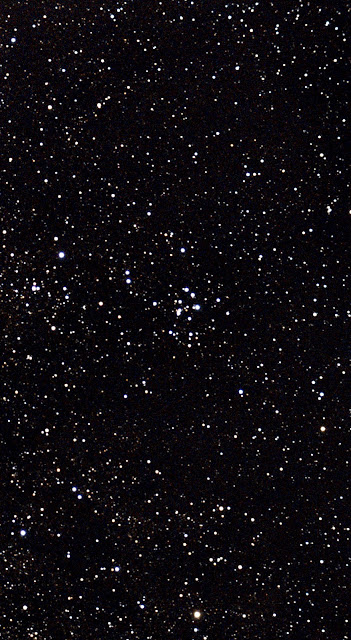Target Variety
The sky was cloudless on September 10th and all five neighbors' spotlights were turned off. Although a nearly first quarter Moon hung in the south, clear conditions were too good to pass up. Forecasts predicted two upcoming cloudy weeks along with a brightening Moon, so I was motivated to take my Seestar outside for some imaging. There was no wind, and temperature ranged from the mid to low 60's.
I've decided to try capturing Seestar images of all 110 objects in the Messier catalog, so I began this night with some globular clusters and open clusters in Sagittarius, Scorpius, and Aquarius while the first quarter Moon continued getting lower in the sky. I've found 10-minute exposures work well for all globular images below. Globular cluster M28 had a relatively small apparent size and appeared among a crowded Sagittarius Milky Way star field in the first image below.
Also located in Sagittarius, dramatic globular cluster M55 is almost twice the apparent size of M28 and is nicely portrayed in the next image.
The central portion of globular M2 in Aquarius seems burned out in the next image. (Click on images to get an enlarged view.)The last member of this night's globular collection is M15 in Pegasus shown next.
Open cluster M23 in Sagittarius features several interesting star chains and patterns in the next 5-minute exposure.Pretty open cluster M6 in Scorpius, also known as the Butterfly Cluster, contains a couple colorful stars and an arrow-like grouping in the next image. M6 was very close to the horizon. I had to end the exposure after only one minute and 40 seconds because rooftops were beginning to show in the bottom of the image. I cropped rooftops out of this image.
Planetary nebula NGC 6818 in the previous image has an apparent angular diameter of only 22 X 15 arc seconds. Many planetary nebulae are similarly small and show up only as small blue-green circles in Seestar images. For example, NGC7662, the Blue Snowball Nebula in the constellation Andromeda, is about 30 arc seconds in diameter. It's the small blue-green circle near center of the next image, a 5-minute exposure.
Another example is planetary nebula NGC 7009 in Aquarius whose apparent size is about 30 X 25 arc seconds. This planetary is called the Saturn Nebula because its elongated shape in small telescopes slightly resembles Saturn's rings. Only a hint of this structure is visible in the next 5-minute exposure.On the other hand, some planetary nebulae, like NGC1501 in Camelopardalis shown in the next 8-minute exposure, are large enough for Seestar to reveal internal structure. NGC1501 has a diameter of about 54 arc seconds. You can see the 14.5 magnitude central star when the image is viewed at full size.
My final planetary nebula for the night was the famous Ring Nebula, M57, in Lyra. Its apparent angular size is about 84 X 66 arc seconds, significantly larger than the previous examples above, so a 5-minute exposure reveals the ring shape and hints of red color.
Camelopardalis is an often overlooked northerly constellation recently featured in the October issue of Sky and Telescope magazine. A suggested target there was open cluster NGC1502 which Seestar captured nicely in the following 5-minute exposure. Enlarge the image to see several close star pairs and a semicircular arc containing nine stars.
I ran out of energy at 1:30 am and brought the dew dampened Seestar inside. At this point I've collected 45 out of the 110 Messier objects and look forward to capturing more in future months.






















